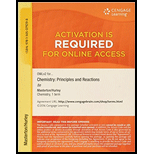
For the zero-order decomposition of ammonia on tungsten
(a) What is the half-life of a 0.250 M solution of ammonia?
(b) How long will it take for the concentration of ammonia to drop from 1.25 M to 0.388 M?
Trending nowThis is a popular solution!

Chapter 11 Solutions
CHEMISTRY:PRIN.+REACTIONS-OWLV2 ACCESS
- At 573 K, gaseous NO2(g) decomposes, forming NO(g) and O2(g). If a vessel containing NO2(g) has an initial concentration of 1.9 102 mol/L, how long will it take for 75% of the NO2(g) to decompose? The decomposition of NO2(g) is second-order in the reactant and the rate constant for this reaction, at 573 K, is 1.1 L/mol s.arrow_forwardSucrose, a sugar, decomposes in acid solution to give glucose and fructose. The reaction is first-order in sucrose, and the rate constant at 25 C is k = 0.21 h1. If the initial concentration of sucrose is 0.010 mol/L, what is its concentration after 5.0 h?arrow_forwardOne possible mechanism for the decomposition of nitryl chloride, NO2CI, is What is the overall reaction? What rate law would be derived from this mechanism? What effect does increasing the concentration of the product NO2 have on the reaction rate?arrow_forward
- The catalyzed decomposition of hydrogen peroxide is first-order in [H2O2]. It was found that the concentration of H2O2 decreased from 0.24 M to 0.060 M over a period of 282 minutes. What is the half-life of H2O2? What is the rate constant for this reaction? What is the initial rate of decomposition at the beginning of this experiment (when [H2O2] = 0.24 M)?arrow_forwardThe hydrolysis of the sugar sucrose to the sugars glucose and fructose, C12H22O11+H2OC6H12O6+C6H12O6 follows a first-order rate equation for the disappearance of sucrose: Rate =k[C12H22O11] (The products of the reaction, glucose and fructose, have the same molecular formulas but differ in the arrangement of the atoms in their molecules.) (a) In neutral solution, k=2.11011s1 at 27 C and 8.51011s1 at 37 C. Determine the activation energy, the frequency factor, and the rate constant for this equation at 47 C (assuming the kinetics remain consistent with the Arrhenius equation at this temperature). (b) When a solution of sucrose with an initial concentration of 0.150 M reaches equilibrium, the concentration of sucrose is 1.65107M . How long will it take the solution to reach equilibrium at 27 C in the absence of a catalyst? Because the concentration of sucrose at equilibrium is so low, assume that the reaction is irreversible. (c) Why does assuming that the reaction is irreversible simplify the calculation in pan (b)?arrow_forwardThe Raschig reaction produces the industrially important reducing agent hydrazine, N2H4, from ammonia, NH3, and hypochlorite ion, OCl−, in basic aqueous solution. A proposed mechanism is Step 1: Step 2: Step 3: What is the overall stoichiometric equation? Which step is rate-limiting? What reaction intermediates are involved? What rate law is predicted by this mechanism?arrow_forward
- Hydrogen peroxide, H2O2(aq), decomposes to H2O() and O2(g) in a reaction that is first-order in H2O2 and has a rate constant k = 1.06 103 min1 at a given temperature. (a) How long will it take for 15% of a sample of H2O2 to decompose? (b) How long will it take for 85% of the sample to decompose?arrow_forwardFor a reaction involving the decomposition of a hypothetical substance Y, these data are obtained: Determine the order of the reaction. Write the rate law for the decomposition of Y. Calculate k for the experiment above.arrow_forwardThe decomposition of gaseous dimethyl ether at ordinary pressures is first-order. Its half-life is 25.0 minutes at 500 C: CH3OCH3(g) CH4(g) + CO(g) + H2(g) (a) Starting with 8.00 g of dimethyl ether, what mass remains (in grams) after 125 minutes and after 145 minutes? (b) Calculate the time in minutes required to decrease 7.60 ng (nanograms) to 2.25 ng. (c) What fraction of the original dimethyl ether remains after 150 minutes?arrow_forward
- Explain why half-lives are not normally used to describe reactions other than first order.arrow_forwardThe decomposition of SO2Cl2 is a first-order reaction: SO2Cl2(g) SO2(g) + Cl2(g) The rate constant for the reaction is 2.8 103 min1 at 600 K. If the initial concentration of SO2Cl2 is 1.24 103 mol/L, how long will it take for the concentration to drop to 0.31 103 mol/L?arrow_forwardThe decomposition of N2O5 in CCl4 is a first-order reaction. If 2.56 mg of N2O5 is present initially and 2.50 mg is present after 4.26 minutes at 55 C, what is the value of the rate constant, k?arrow_forward
 Chemistry & Chemical ReactivityChemistryISBN:9781337399074Author:John C. Kotz, Paul M. Treichel, John Townsend, David TreichelPublisher:Cengage Learning
Chemistry & Chemical ReactivityChemistryISBN:9781337399074Author:John C. Kotz, Paul M. Treichel, John Townsend, David TreichelPublisher:Cengage Learning Chemistry & Chemical ReactivityChemistryISBN:9781133949640Author:John C. Kotz, Paul M. Treichel, John Townsend, David TreichelPublisher:Cengage Learning
Chemistry & Chemical ReactivityChemistryISBN:9781133949640Author:John C. Kotz, Paul M. Treichel, John Townsend, David TreichelPublisher:Cengage Learning General Chemistry - Standalone book (MindTap Cour...ChemistryISBN:9781305580343Author:Steven D. Gammon, Ebbing, Darrell Ebbing, Steven D., Darrell; Gammon, Darrell Ebbing; Steven D. Gammon, Darrell D.; Gammon, Ebbing; Steven D. Gammon; DarrellPublisher:Cengage Learning
General Chemistry - Standalone book (MindTap Cour...ChemistryISBN:9781305580343Author:Steven D. Gammon, Ebbing, Darrell Ebbing, Steven D., Darrell; Gammon, Darrell Ebbing; Steven D. Gammon, Darrell D.; Gammon, Ebbing; Steven D. Gammon; DarrellPublisher:Cengage Learning Chemistry: Principles and ReactionsChemistryISBN:9781305079373Author:William L. Masterton, Cecile N. HurleyPublisher:Cengage Learning
Chemistry: Principles and ReactionsChemistryISBN:9781305079373Author:William L. Masterton, Cecile N. HurleyPublisher:Cengage Learning Chemistry: Principles and PracticeChemistryISBN:9780534420123Author:Daniel L. Reger, Scott R. Goode, David W. Ball, Edward MercerPublisher:Cengage Learning
Chemistry: Principles and PracticeChemistryISBN:9780534420123Author:Daniel L. Reger, Scott R. Goode, David W. Ball, Edward MercerPublisher:Cengage Learning Chemistry: The Molecular ScienceChemistryISBN:9781285199047Author:John W. Moore, Conrad L. StanitskiPublisher:Cengage Learning
Chemistry: The Molecular ScienceChemistryISBN:9781285199047Author:John W. Moore, Conrad L. StanitskiPublisher:Cengage Learning





